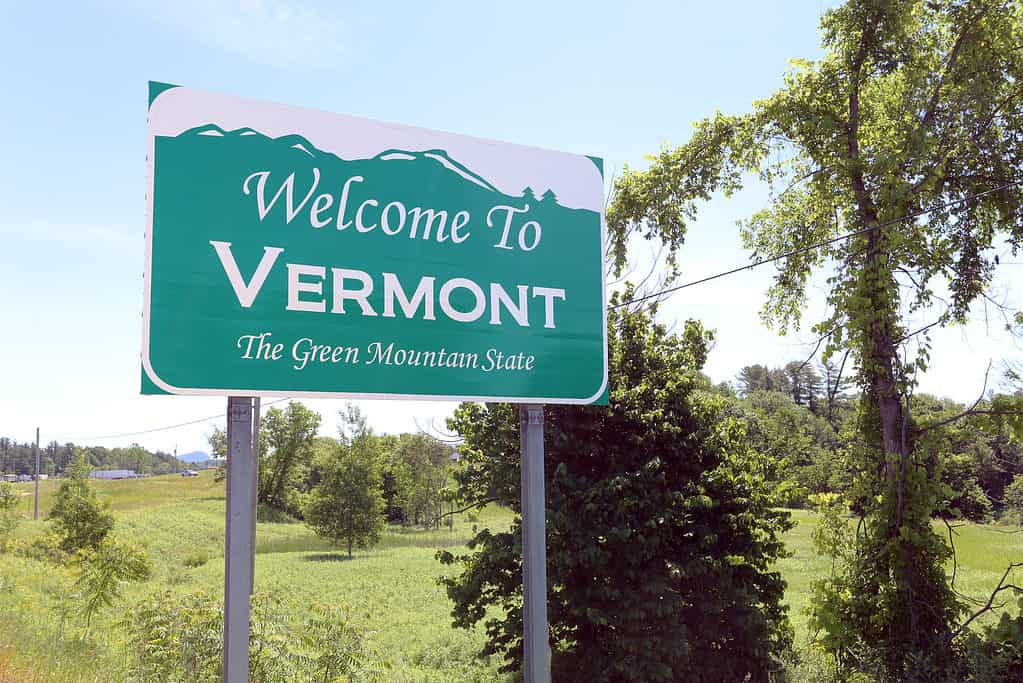Vermont is in the Northeastern United States, and area of the country known for its snowy winters and warm, humid summers. This article explores the hottest place in Vermont, including its location, history, average temperatures, record temperatures, and wildlife.

Vermont’s official nickname is The Green Mountain State.
©Katherine Welles/Shutterstock.com
The Hottest Place in Vermont
Although the annual mean temperature in Vermont is only 43 °F, summers can still get fairly warm. The hottest place in Vermont is Vernon, a small town in Windham County. Read on to discover the average and record temperatures of Vernon, VT.
Vernon Location
Vernon is in Windham County, which is in southeastern Vermont. Windham County borders Windsor County to the north and Bennington County to the east. Additionally, it borders Massachusetts to the south and New Hampshire to the east. The Connecticut River runs along the town’s eastern border, with New Hampshire lying on the other side of the river. Additionally, the town of Northfield, MA lies across Vernon’s southern border.
Vernon is located 124 miles southeast of Burlington, the largest city in Vermont. Additionally, it is 104 miles south of Montpelier, the capital of Vermont. Finally, Vernon is just 78 miles northwest of Boston, the capital and largest city in Massachusetts.
Vernon History
The town of Vernon was originally named Hinsdale, New Hampshire in 1753. It was established by Benning Wentworth, the first royal governor of New Hampshire, and included land on both sides of the Connecticut River. When Vermont was admitted to the Union in 1791, the Connecticut River became the border between Vermont and New Hampshire. The western half of Hinsdale became Vermont, while the eastern half remained in New Hampshire. However, having two towns across the river from each other both named Hinsdale was a cause for confusion. In 1802, a decision was reached at a town meeting to change Hinsdale, Vermont’s name to Vernon. This name was for Admiral Edward Vernon, a British Royal Navy officer and friend of the Washington family. According to Vernon’s website, the name was suggested by a woman at the town meeting, making Vernon the only Vermont town named by a woman.
Today, Vernon is a small, peaceful community with a municipal forest and a beautiful public beach on the Connecticut River. According to the 2020 United States census, Vernon has a population of 2,192.
Average Temperatures
Summers in Vermont are typically warm and short. The hottest months of the year in Vernon are June, July, and August. July is the hottest month of the year in Vernon. The average high in July is 84 ºF. August falls just behind July, with an average high of 82 ºF. The average high in June is 79 ºF. Summer nights in Vernon are a bit cooler. The average lows in June, July, and August are 54, 59, and 57 ºF.
In contrast, winters in Vernon are typically quite cold. The average high in January, the coldest month of the year, is 32 ºF. The average low in January is 11 ºF. February is only slightly warmer, with an average high of 36 ºF and an average low of 13 ºF.
Record Temperatures
According to the National Oceanic and Atmospheric Administration (NOAA), the town of Vernon holds the record for the hottest temperature ever recorded in Vermont. Vernon set the scorching record of 107 ºF on July 7, 1912.
If this record is ever potentially broken, it will need to be investigated and confirmed by a new committee of the NOAA. In 2006, the NOAA created the State Climate Extremes Committee (SCEC) to investigate potential state record-breaking or -tying temperature readings. These readings can be inaccurate due to mechanical error or the presence of a radiant heat source near the measurement tool. Since there is potential for error, and accurate temperature readings are important for climate data tracking, the SCEC investigates these readings in order to confirm or deny them.
Wildlife Near Vernon

Wood ducks thrive in the black gum swamps of the hottest place in Vermont.
©Rudolf Ernst/Shutterstock.com
Vernon is home to the J. Maynard Miller Municipal Forest and black gum swamps. These lush woods feature black gum trees (Nyssa sylvatica) that are over 400 years old. The forest and wetlands are important wildlife habitats, especially for amphibians. Some of the amphibian species in the black gum swamps of Vernon are the eastern newt, wood frog, green frog, gray treefrog, spring peeper, redback salamander, and dusky salamander.
Additionally, the swamps are home to several interesting mammals and birds. The swamps are an ideal habitat for the North American black bears that live there. A few of the bird species that live in the black gum swamps are the wood duck, Canada warbler, northern waterthrush, and red-shouldered hawk.
Where is Vernon Located On a Map?
Vernon, located in Windham County, Vermont, USA, is a town with a population of 2,192 according to the 2020 census.
Here it is on a map:
The photo featured at the top of this post is © Wallace Weeks/Shutterstock.com
Thank you for reading! Have some feedback for us? Contact the AZ Animals editorial team.







